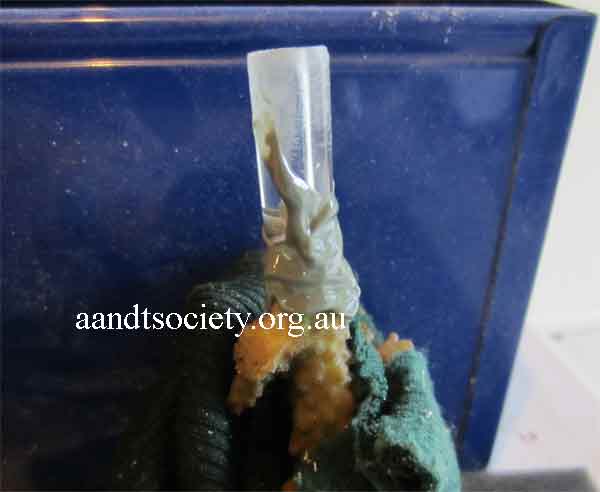Fraging corals,spike style.
South East Queensland Marine Aquarium and Ocean activities Forum :: SEQMAOAF :: Advice on all marine aquarium issues
Page 1 of 1
 Fraging corals,spike style.
Fraging corals,spike style.
Just another way to frag corals that some hobbyists may find usefull for a confined space way of fraging small acropora sps corals.
The photos show the different stages in which to use this way of fraging.
This way involves the use of acrylic rod; the one I purchased has a small hole down the centre to help strengthen the gluing process.
Then rod diameter has to match the drill bit for the holes drilled into your live rock or the rod should be a millimetre or two smaller.
My masonry drill bit that I use with the impact function on the drill is 10 mill and the rod is 9 mill in diameter.

For mine I have cut 35 mill lengths with a diamond-cutting disk on the angle grinder.

The end of this short length was cut in a way that if the glue does not attach well it can not move due to the gouges in the plastic.

Select the corals you wish to use and wrap them in material soaked in aquarium water.
Sit the corals on sponge or similar while working on them.

Grind the ends of your corals to enable glue to set and not release.
Dry the coral part that has been ground with tissue paper ready for gluing.

Glue on the piece of acrylic by pushing the glue into all gouges of both the acrylic and the corals.

Leave coral in suitable water while glue sets supporting the acrylic depending on which glue you use. I use a ten-minute epoxy resin that is rigid to a degree in thirty minutes and rock hard the next day.

Glue is set and the acrylic rod is ready to be placed in the suitable hole in the live rock.

The acrylic end glued to the coral has been placed in it’s hole drilled previously into the live rock and the frag is now in place and ready grow.

Spike style end result.

The photos show the different stages in which to use this way of fraging.
This way involves the use of acrylic rod; the one I purchased has a small hole down the centre to help strengthen the gluing process.
Then rod diameter has to match the drill bit for the holes drilled into your live rock or the rod should be a millimetre or two smaller.
My masonry drill bit that I use with the impact function on the drill is 10 mill and the rod is 9 mill in diameter.

For mine I have cut 35 mill lengths with a diamond-cutting disk on the angle grinder.

The end of this short length was cut in a way that if the glue does not attach well it can not move due to the gouges in the plastic.

Select the corals you wish to use and wrap them in material soaked in aquarium water.
Sit the corals on sponge or similar while working on them.

Grind the ends of your corals to enable glue to set and not release.
Dry the coral part that has been ground with tissue paper ready for gluing.

Glue on the piece of acrylic by pushing the glue into all gouges of both the acrylic and the corals.

Leave coral in suitable water while glue sets supporting the acrylic depending on which glue you use. I use a ten-minute epoxy resin that is rigid to a degree in thirty minutes and rock hard the next day.

Glue is set and the acrylic rod is ready to be placed in the suitable hole in the live rock.

The acrylic end glued to the coral has been placed in it’s hole drilled previously into the live rock and the frag is now in place and ready grow.

Spike style end result.

_________________
Forum Admin

liquidg- Posts : 2782
Join date : 2010-02-02
Location : Brisbane bayside
 Similar topics
Similar topics» Coral fragging,spike style.
» Stingray weapon/spike.
» Corals bleaching
» light for corals
» can you collect Corals,if so where?
» Stingray weapon/spike.
» Corals bleaching
» light for corals
» can you collect Corals,if so where?
South East Queensland Marine Aquarium and Ocean activities Forum :: SEQMAOAF :: Advice on all marine aquarium issues
Page 1 of 1
Permissions in this forum:
You cannot reply to topics in this forum
 Home
Home